Blog
Tiger Woods Breaks Down His Iron Game – Use These Tips
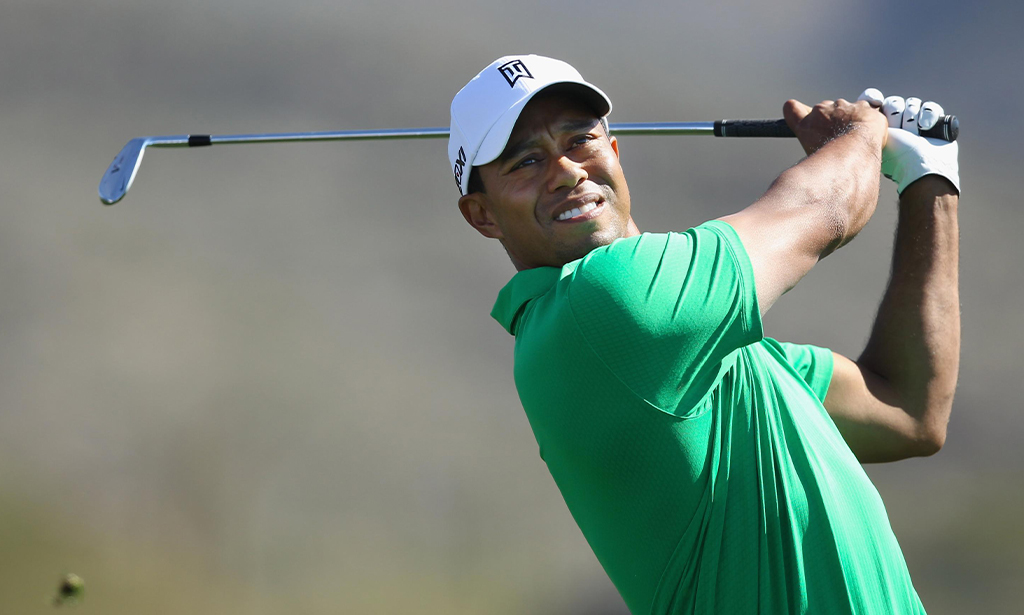
My swing and my game have evolved over the years, but one thing has remained consistent: I’m always confident with an iron in my hand.
I’m not one of the longest hitters on tour anymore—I can’t hit a wedge 150-plus yards like some guys do—so my iron game is absolutely critical to my success at this stage. It sounds simple, but the best way to make birdies is to hit your approaches close. To do that, you need to have distance control, which is possible only with consistent contact. For example, I hit my irons so pure last year at Augusta, and because of that, I had a ton of good looks at birdie. Two specific shots from Sunday’s final round come to mind: On 7, when I needed a birdie to jump-start the round, I hit my trusted low, trapping fade to tap-in range. Then on 16, I hit a high-draw 8-iron that plopped down in the perfect spot, took the slope and finished about three feet from the cup. That birdie gave me a two-shot lead and firm control of the tournament.
Note that one of those shots was a low fade and the other a high draw. I’ve always taken pride in my ability to vary trajectory and shape the ball both ways. Very few of my iron shots look exactly the same. Still, there are a few basics I try to apply to every iron shot, and they’re principles you can use for your game.
The first thing I do is take a good look at the lie. Is it anything out of the ordinary? Is it above or below my feet?
Is it in a divot? If it’s in the rough, is it a flyer?
Once I assess the lie, I shift my focus to the green complex. I like to let the course dictate what type of shot I’m trying to hit. Where is the exact spot I want the ball to land? Generally, I tend to hit more draws to left pins and fades to right pins, but there are exceptions. For example, sometimes it’s more important to have the ball working away from a hazard than toward the flag. Amateurs don’t think enough about things like that before they start their pre-shot routine.
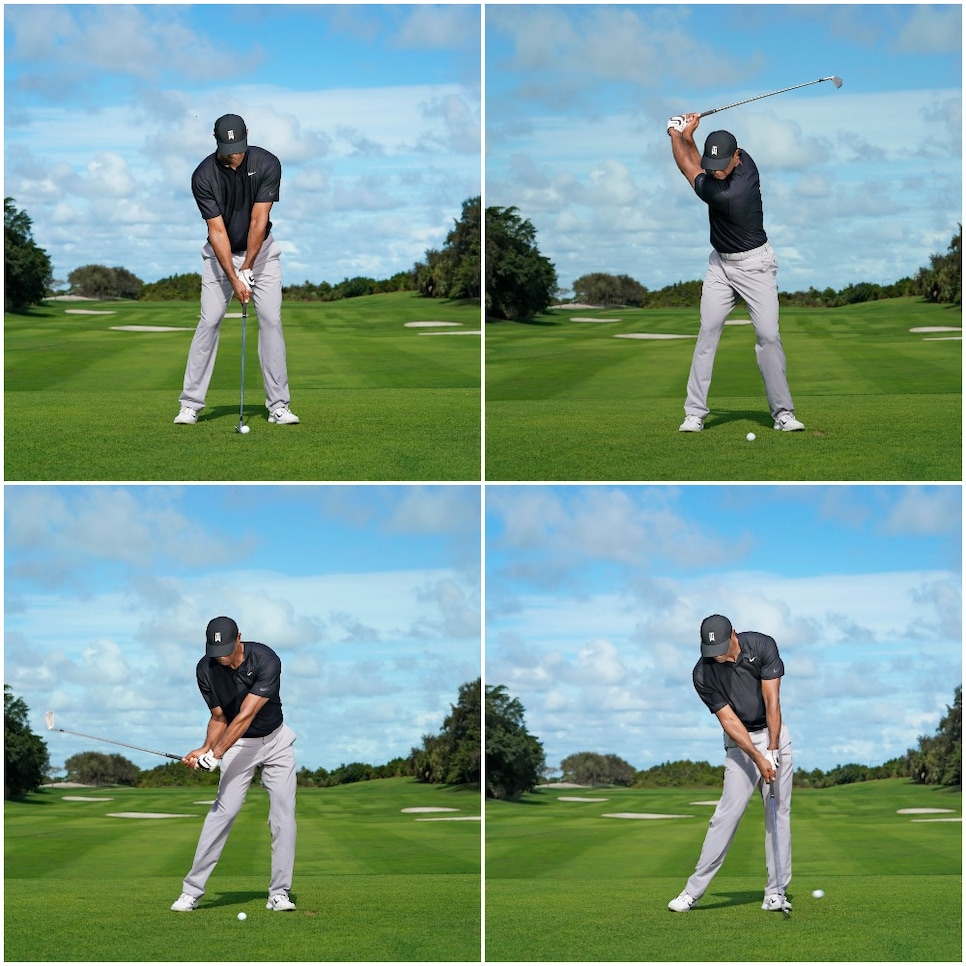
As far as my setup, because of all my back issues, I’ve tried to avoid side bend in my swing, and that all starts with how I stand to the ball. I like to find a balanced and athletic posture that’s free of any tension in my arms or shoulders.
A good thought for me, and one that should help you make solid contact, is to keep your shoulders, hips and knees stacked on the same vertical plane throughout the motion. My baseline is to be as neutral as possible at address, with everything square to the target—then I’ll make adjustments to my stance and clubface for a draw or a fade, or for a low shot or a high shot.
I play the ball a bit farther forward in my stance than the average tour pro—it’s just my preference—and as a result I tend to sweep my irons more than dig. I’ll move the ball one ball forward in my stance if I’m trying to hoist one up, and I’ll play one ball back of normal if I’m trying to flight it down.
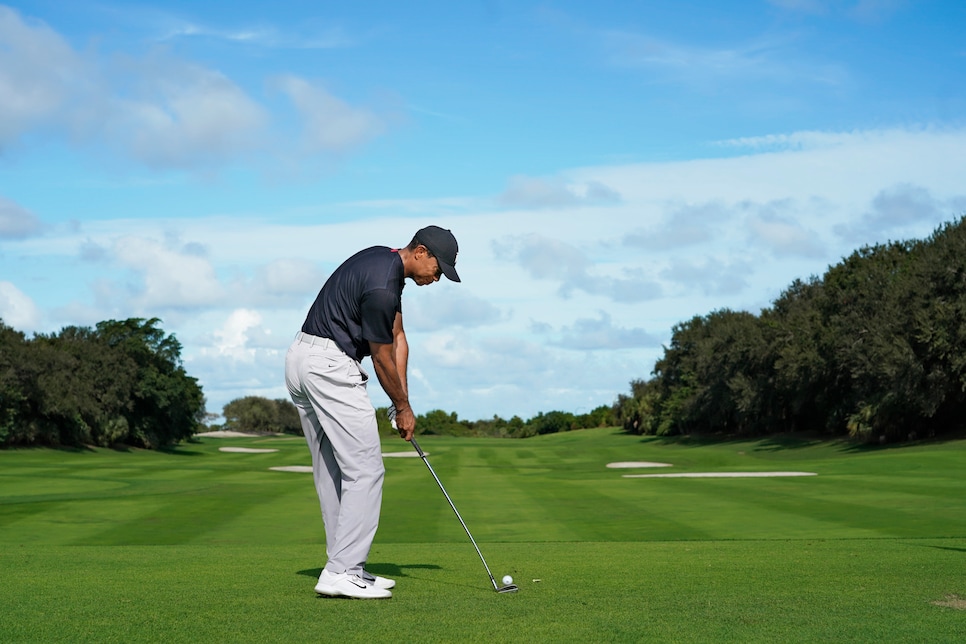
J.D. Cuban
When I swing, my thoughts are pretty simple and more feel-oriented than technical. I don’t watch my swing on video too often. I prefer to feel things with my hands, then confirm with my buddy Rob McNamara that he sees what I’m feeling.
My backswing has changed quite a bit throughout the years. I used to load up much more on my right side and try to create as much width as possible. As a result, my weight would move to my right leg, and my head would slide laterally away from the target. That’s how a young man swings the club. Now, to put less strain on my body, I try to keep my head and chest more stable and turn more around my right side.
To a large extent, my backswing is a function of my setup. At certain times in my career, I’ve had my hands lower or higher at address. For me, lower hands resulted in an earlier wrist set, and higher hands resulted in a later one. Now I feel like I’m quite neutral with my setup, which leads to a wrist set that happens around rib height.
Once I’ve completed my backswing—which almost always stops short of parallel because I’m concerned with hitting the ball the right distance, not the farthest distance—my main thought is to push down into the ground and clear my hips. That’s one reason my latest knee scope was so important. Toward the end of the summer, pain in my left knee prevented me from pushing hard. I was sliding a bit, which made it nearly impossible to get the hip rotation I needed to hit my cut. My other thought is to not let my hands get stuck behind me, which leads to having to save the swing and manipulate the face with my hands—that’s no good. The best way to avoid getting stuck is to not let the lower body out-race the hands on the downswing. My thought is to have everything synced when I reach impact.
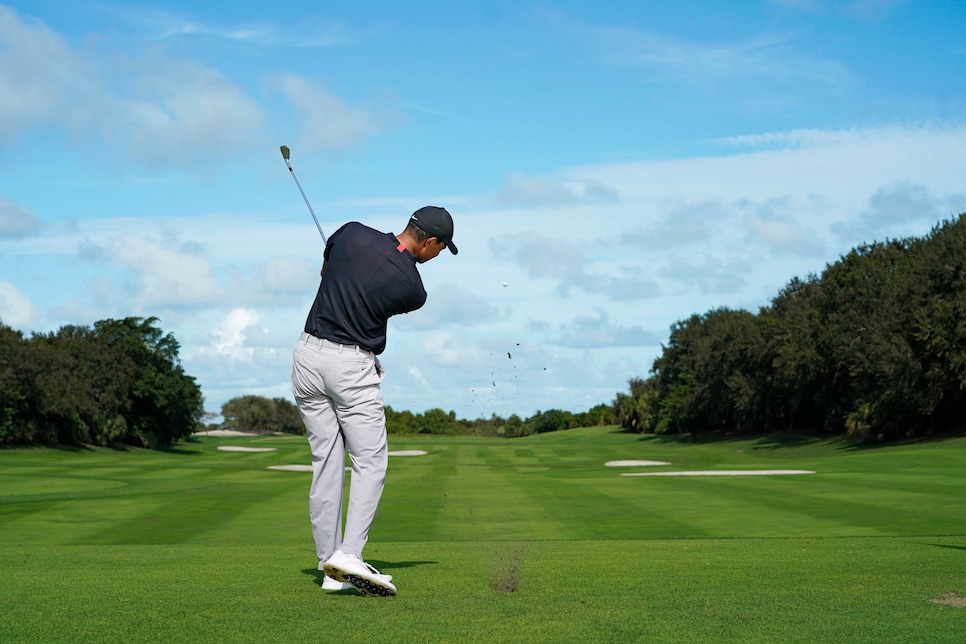
J.D. Cuban
I like to think that my follow-through determines how high the ball is going to launch. In reality, my follow-through is a result of my angle of attack. When I’m steeper and trying to flight it down, I feel like I cut off the swing shortly after impact. If I shallow it out to launch the ball really high, I throw my hands way up over my head and let them finish over my left shoulder.
Again, I’m a shotmaker at heart, and one of my favorite parts of playing golf is carving iron shots. I wouldn’t recommend amateurs try to work it as much as I do, but the basics I’ve laid out here will help you make better contact, which will allow you to hit the ball the right distance—and hopefully give yourself some tap-in birdies like I had at last year’s Masters. –with Daniel Rapaport
This article originally appeared on Golf Digest.
Blog
Unveiling the History and Symbolism of Iconic Golf Trophies
Golf is a sport steeped in tradition, prestige, and class. From the lush greens of the course to the meticulously designed clubs, each aspect of the game exudes a sense of history and elegance.
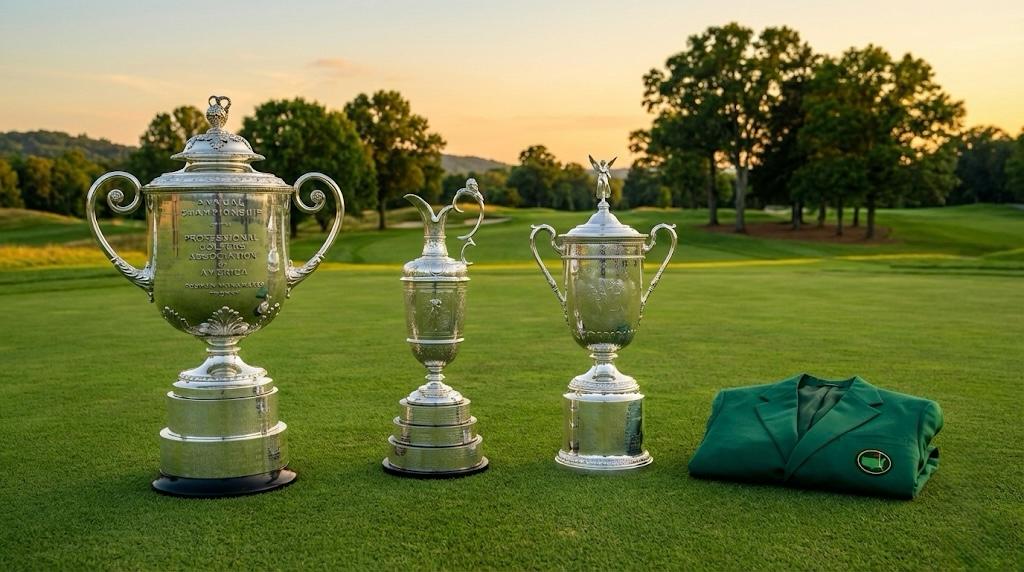
Golf is a sport steeped in tradition, prestige, and class. From the lush greens of the course to the meticulously designed clubs, each aspect of the game exudes a sense of history and elegance. Among these elements, golf trophies – the coveted prizes of the tournament – hold a special place. These iconic awards not only represent the winning golfer’s skill and determination but also carry a rich history and meaningful symbolism. In this article, we’ll delve into the story behind some of the most iconic golf trophies and what they symbolize, offering a unique perspective on this beloved sport.
The Claret Jug: The Open Championship
The Claret Jug, officially known as The Golf Champion Trophy, is awarded to the winner of The Open Championship, one of the four major championships in professional golf. The trophy, first presented in 1873, replaced the original prize of a red leather belt with silver buckle.
Its design is based on the medieval ‘claret jugs’ used to serve wine. The symbolism here lies in the association of the jug with a time-honored tradition, reflecting the essence of the tournament itself. The names of all the previous winners are inscribed on the jug, creating a tangible link to the history of the sport.
The Green Jacket: The Masters Tournament
At The Masters Tournament, one of the most prestigious events in golf, the winner is honored with a distinctive green jacket. The tradition began in 1937 when members of the Augusta National Golf Club wore green jackets to distinguish themselves from the crowd.
The symbolism of the Green Jacket is twofold. Firstly, it represents membership of an exclusive club, as only winners of The Masters or members of the Augusta National Golf Club are entitled to wear it. Secondly, the green color reflects the lush, pristine condition of the golf course, a crucial aspect of the sport.
The Wanamaker Trophy: PGA Championship
The Wanamaker Trophy, awarded to the winner of the PGA Championship, is named after Rodman Wanamaker, who played a significant role in establishing the Professional Golfers’ Association of America. It’s one of the largest trophies in professional golf, standing nearly 2.5 feet tall and weighing 27 pounds.
The size and weight of the Wanamaker Trophy symbolize the magnitude and prestige of the tournament it represents. Moreover, engraved on its silver surface are the names of past champions, honoring the legacy of the game.
The U.S. Open Trophy
The U.S. Open Trophy, awarded to the winner of the U.S. Open, dates back to 1895. The trophy was destroyed in a fire in 1946 and had to be recreated from photographs of the original.
The trophy is a sterling silver cup, adorned with elaborate ornamentation. The names of previous winners are engraved on the base, acknowledging the tournament’s rich history. The trophy represents the pinnacle of achievement in American golf, symbolizing the grit and determination required to prevail in one of the sport’s most challenging competitions.
Golf trophies are more than just symbols of individual triumph; they are embodiments of the rich history, tradition, and enduring spirit of the game. From the Claret Jug’s reflection of time-honored tradition to the Green Jacket’s symbolization of exclusivity and pristine golfing conditions, each trophy carries a unique story and meaning. These iconic awards, while coveted for their prestige, also serve as a timeless reminder of the sport’s enduring allure and the unforgettable moments that define golf history.
Blog
The Most Dramatic Final-Day Finishes in Major Sports Tournaments
Many sports have some nail bitting finishes. Robert Greenfield recaps some major final day finishes in sports history.

The final day of major sports tournaments often delivers an exhilarating end to the competition that keeps fans on the edge of their seats. There’s no better testament to the suspense and drama of sports than those last-minute turnarounds, nail-biting finishes, and underdog triumphs that define the beauty of competition. This article will take you on a thrilling journey through some of the most dramatic final-day finishes in major sports tournaments, reminding us all why we love sports in the first place.
-
- The Miracle of Istanbul – 2005 UEFA Champions League Final
The 2005 UEFA Champions League Final between Liverpool and AC Milan is etched in the annals of football history as one of the most dramatic comebacks ever witnessed. AC Milan, boasting a star-studded lineup, went into halftime with a seemingly unassailable 3-0 lead. However, Liverpool had other plans. In a six-minute spell after halftime, the Reds staged an incredible comeback to level the match at 3-3, eventually winning the game on penalties. The victory was a testament to the never-say-die spirit of Liverpool and the unpredictability of football.
-
- The “Shot Heard ‘Round the World” – 1951 National League Pennant Playoff
In baseball’s history, few moments match the drama of the 1951 National League Pennant Playoff. The New York Giants and the Brooklyn Dodgers were facing off in a three-game playoff to determine the National League champion. In the bottom of the ninth inning of the decisive third game, with the Giants trailing 4-2, Bobby Thomson hit a game-winning three-run homer off Dodgers pitcher Ralph Branca. This legendary moment, known as the “Shot Heard ‘Round the World,” is one of the most iconic in baseball history.
-
- The 1999 Ryder Cup “Battle of Brookline”
The 33rd Ryder Cup, held at The Country Club in Brookline, Massachusetts, saw one of the greatest comebacks in the history of golf. The United States trailed Europe 10-6 heading into the final day, but in a stunning display of determination and skill, the American team clawed back to win 14.5-13.5. The victory, known as the “Battle of Brookline,” is still celebrated as a pivotal moment in golf history.
-
- The 1980 “Miracle on Ice”
One of the most dramatic moments in the history of ice hockey came during the 1980 Winter Olympics. The heavily favored Soviet Union team was expected to sweep the gold, but the underdog United States team had different plans. In a game filled with tension and drama, the U.S. team defeated the Soviets 4-3 in a match now known as the “Miracle on Ice.” This victory is not only iconic in the sport of ice hockey but also a significant moment in American sports history.
- The 2019 Cricket World Cup Final
The final of the 2019 Cricket World Cup between England and New Zealand was filled with unprecedented drama and suspense. Both teams ended their innings tied on 241 runs, leading to a Super Over – cricket’s version of a tiebreaker. Incredibly, the Super Over also ended in a tie, with both teams scoring 15 runs. England was ultimately declared the winner on the basis of a boundary countback rule, marking their first-ever World Cup victory.
Conclusion
The unpredictability, suspense, and drama are what make sports so captivating. These dramatic final-day finishes remind us of the thrilling highs and lows that come with the world of competitive sports. As fans, we live for these moments, cherishing the unexpected triumphs and heartbreaking defeats. The next time you find yourself watching the final day of a major sports tournament, remember these historic moments and brace yourself for the potential drama that could unfold.
Blog
Weather and the Game: The Undeniable Influence of Elements on Championship Outcomes
Learn how weather affects different championship outcomes.

Introduction
As a sports enthusiast, you might have noticed that weather plays a significant role in sporting events, particularly in championships. From the power of a baseball pitch to the course of a golf ball, from the strength of a football kick to the stride of a marathon runner – the elements can influence each of these and more. In this article, we delve into the fascinating intersection of meteorology and sports, examining how weather conditions can make or break a championship game.
The Impact of Weather on Different Sports
Whether it’s football, baseball, golf, tennis, or marathon, each sport faces unique challenges when it comes to weather. Let’s delve into the specifics:
Football and Weather Elements
Football is a sport that’s played in almost all weather conditions except for severe ones like lightning storms. However, weather elements have a significant impact on the game.
-
- Rain: A wet field makes the ball slippery, impacting players’ ability to handle, pass, or kick the ball accurately. Rain can also make the field muddy, affecting the players’ ability to move swiftly.
- Wind: Strong wind can alter the trajectory of the ball, affecting passes and kicks.
- Cold: Extremely cold temperatures can affect players’ physical performance and endurance, while also making the ball harder and more challenging to catch.
Baseball and Weather Elements
Baseball is another sport where weather conditions can significantly influence the outcome.
-
- Wind: The direction and speed of the wind can affect the trajectory and distance a baseball travels.
- Humidity: High humidity can make the ball denser, potentially reducing its bounce and speed.
- Temperature: Low temperatures can make the ball harder, affecting its bounce and the players’ ability to grip and hit it effectively.
Golf, Tennis, and Marathons
Weather conditions play an equally crucial role in golf, tennis, and marathons.
-
- Wind: In golf, the wind can alter the ball’s direction and distance. In tennis, wind can affect ball control, altering serves and volleys.
- Temperature: Extreme heat can affect a marathon runner’s performance significantly, leading to dehydration and exhaustion.
- Rain: In golf, a wet course can slow down the ball, while in tennis, a wet court can make the ball bounce irregularly.
Case Studies: Weather Influencing Championship Outcomes
This section presents some examples of games where weather conditions significantly influenced the outcome.
- The “Ice Bowl” (1967): The NFL Championship game between the Green Bay Packers and the Dallas Cowboys, often referred to as the “Ice Bowl,” witnessed one of the coldest conditions in NFL history, affecting players’ performance and the final outcome.
- The “Windy City” World Series (1945): The World Series game between the Chicago Cubs and Detroit Tigers was so affected by the wind that it changed the trajectory of the baseball multiple times, influencing the game’s final score.
- Wimbledon Championships (2019): The final match between Novak Djokovic and Roger Federer was played with the Centre Court’s roof closed due to rain, limiting the natural elements’ effects and perhaps altering the match’s dynamics.
Conclusion
The impact of weather on sports is an exciting field of study, revealing how the natural elements influence games and championships. From altering the trajectory of a ball to affecting a player’s physical performance, weather can indeed be a game-changer. As fans and enthusiasts, understanding these influences can add another layer of excitement and anticipation to our favorite sports.
So the next time you attend or watch a game, remember to check the weather forecast. It might just give you a sneak peek into the game’s possible outcome!
-

 Product Review6 years ago
Product Review6 years agoThe Perfect Practice Putting Mat Review by Jason Tenzer
-

 Blog4 years ago
Blog4 years agoLoophole Rule Offers PGA Tour Pros a Mulligan
-

 Blog4 years ago
Blog4 years ago2021 Buyer’s Guide: The Top 10 Value Golf Balls For Distance & Feel
-

 Blog5 years ago
Blog5 years agoGolf Marriage Counselor
-

 Blog6 years ago
Blog6 years ago9 Biggest Chokes Of The Past Decade
-

 Product Review6 years ago
Product Review6 years agoTHE ADJUSTABLE IRONS: WALKING STICKS GOLF CLUBS
-

 Blog4 years ago
Blog4 years agoWhat Your Golf Clubs Say About You
-

 Equipment6 years ago
Equipment6 years agoOHK Sports Interview by Jason Tenzer






























